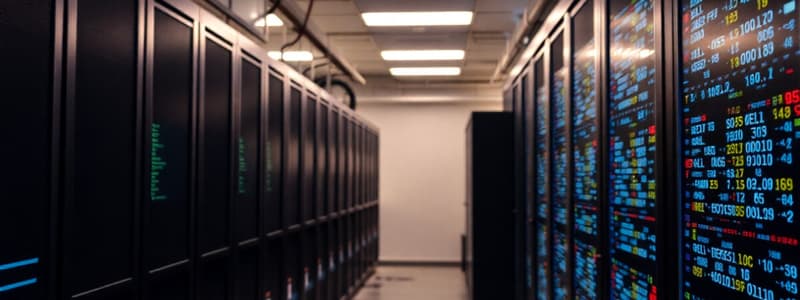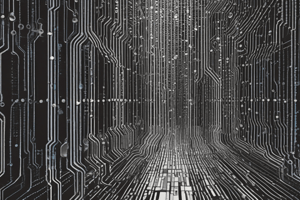Podcast
Questions and Answers
What characterizes a non-positional number system?
What characterizes a non-positional number system?
- The value of digits is dependent on their position within a number.
- Digits represent fixed values regardless of their position. (correct)
- The base of the system must always be 10.
- Digits can only be the basic symbols 0 and 1.
Which number system operates with a base of 8?
Which number system operates with a base of 8?
- Hexadecimal Number System
- Decimal Number System
- Octal Number System (correct)
- Binary Number System
In the hexadecimal number system, which of the following symbols represents the decimal value 14?
In the hexadecimal number system, which of the following symbols represents the decimal value 14?
- E (correct)
- D
- F
- A
What is the main feature of positional number systems compared to non-positional systems?
What is the main feature of positional number systems compared to non-positional systems?
Which of the following is NOT a characteristic of the decimal number system?
Which of the following is NOT a characteristic of the decimal number system?
What is the primary role of the Input Unit in a computer system?
What is the primary role of the Input Unit in a computer system?
Which component is referred to as the brain of the computer?
Which component is referred to as the brain of the computer?
Which of the following accurately describes the function of the Control Unit?
Which of the following accurately describes the function of the Control Unit?
What distinguishes primary storage from secondary storage?
What distinguishes primary storage from secondary storage?
Which of the following represents a non-volatile type of storage?
Which of the following represents a non-volatile type of storage?
Which devices primarily act as input units?
Which devices primarily act as input units?
Which of the following is NOT a function of the CPU?
Which of the following is NOT a function of the CPU?
Which type of memory is typically used for temporary data storage during processing?
Which type of memory is typically used for temporary data storage during processing?
What is the primary function of the Output Unit in a computer system?
What is the primary function of the Output Unit in a computer system?
Which type of computer is most commonly used for personal tasks like word processing and internet browsing?
Which type of computer is most commonly used for personal tasks like word processing and internet browsing?
Minicomputers are best suited for which of the following purposes?
Minicomputers are best suited for which of the following purposes?
Which type of computer is characterized by its ability to process large volumes of data and is commonly used by large corporations?
Which type of computer is characterized by its ability to process large volumes of data and is commonly used by large corporations?
Which of the following statements is true about supercomputers?
Which of the following statements is true about supercomputers?
What types of users primarily utilize minicomputers?
What types of users primarily utilize minicomputers?
Which is a notable example of a supercomputer?
Which is a notable example of a supercomputer?
What feature distinguishes microcomputers from other types of computers?
What feature distinguishes microcomputers from other types of computers?
What characterizes volatile memory?
What characterizes volatile memory?
Which type of RAM does not require periodic refreshing?
Which type of RAM does not require periodic refreshing?
Why is DRAM considered cost-effective for main memory?
Why is DRAM considered cost-effective for main memory?
Which memory type can be programmed only once after manufacturing?
Which memory type can be programmed only once after manufacturing?
Which of the following memories can be erased with ultraviolet light?
Which of the following memories can be erased with ultraviolet light?
How does non-volatile memory differ from volatile memory?
How does non-volatile memory differ from volatile memory?
Which type of ROM stores firmware that cannot be modified?
Which type of ROM stores firmware that cannot be modified?
What is unique about machine language compared to other programming languages?
What is unique about machine language compared to other programming languages?
What is a primary characteristic of EEPROM?
What is a primary characteristic of EEPROM?
What do assembly languages primarily use to represent machine code instructions?
What do assembly languages primarily use to represent machine code instructions?
Which of the following is NOT an example of a high-level language?
Which of the following is NOT an example of a high-level language?
Which type of high-level language organizes programs around objects?
Which type of high-level language organizes programs around objects?
What distinguishes scripting languages from other high-level programming languages?
What distinguishes scripting languages from other high-level programming languages?
What is a key characteristic of declarative languages?
What is a key characteristic of declarative languages?
Which of the following programming languages is considered an example of a procedural language?
Which of the following programming languages is considered an example of a procedural language?
Which programming language type is known for allowing the automation of tasks and rapid prototyping?
Which programming language type is known for allowing the automation of tasks and rapid prototyping?
Flashcards are hidden until you start studying
Study Notes
Computer Systems
- A computer system consists of three main parts: Input Units, CPU, and Output Units.
- Input Units gather data, convert it into machine-readable form, and connect the user to the computer.
- The CPU acts as the brain of the computer, performing arithmetic and logical operations, controlling all computer components, software, and data processing.
- Output Units accept data from the main memory in binary form and convert it into a human-readable form.
Number Systems
- Positional Number Systems: Value of each digit depends on its position in the number.
- Decimal Number System: Base 10, uses digits 0-9.
- Binary Number System: Base 2, uses digits 0 and 1.
- Octal Number System: Base 8, uses digits 0-7.
- Hexadecimal Number System: Base 16, uses digits 0-9 and A-F (representing 10-15).
Types of Computers
- Microcomputers: Designed for individual use, small and affordable, used for general tasks (word processing, browsing, gaming).
- Minicomputers: Mid-range computers, more powerful than microcomputers, used for specific tasks in small to medium businesses.
- Mainframe Computers: Large, powerful systems designed for handling massive data volumes, used by corporations and large organizations.
- Supercomputers: Most powerful computers, capable of intense calculations used for specific scientific research, complex modeling, and weather forecasting.
Programming Languages
- Machine Language: Most basic level, directly executed by the CPU, uses binary code (0s and 1s) for instructions.
- Assembly Language: Uses mnemonics for instructions, slightly higher level than machine code, requires assembler for translation.
- High-Level Languages: Easier for humans to read and understand, use natural language constructs, examples include C, Python, Java, C++.
Types of High-Level Languages
- Procedural Languages: Focus on step-by-step procedures to solve problems, programs are sequences of instructions.
- Object-Oriented Languages: Model real-world entities as objects with properties and behaviors, programs are organized around interacting objects.
- Scripting Languages: Interpreted rather than compiled, suitable for rapid development, often used for automation, web development, and system administration.
- Declarative Languages: Focus on what the program should achieve, rather than how, used for managing tasks in real-time.
Memory Types
- Volatile Memory: Requires constant power supply to retain data, lost when power is off (temporary storage).
- RAM (Random Access Memory): Volatile, allows quick access to data, stores operating systems, applications, and active data.
- SRAM (Static RAM): Faster and more reliable than DRAM, used for cache memory in processors.
- DRAM (Dynamic RAM): Slower than SRAM, but cost-effective and has higher storage capacity, used for main memory.
- Non-Volatile Memory: Retains data even without power, suitable for permanent storage.
- ROM (Read-Only Memory): Stores rarely changing data, cannot be modified after manufacturing.
- PROM (Programmable ROM): Blank memory that can be programmed once.
- EPROM (Erasable Programmable ROM): Erasable using ultraviolet light.
- EEPROM (Electrically Erasable Programmable ROM): Erasable using electrical charge.
Studying That Suits You
Use AI to generate personalized quizzes and flashcards to suit your learning preferences.




